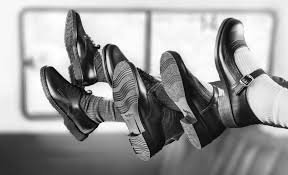
School Shoes
In the conversation around improving education, most discussions focus on curriculum design, teaching quality, and classroom technology. However, often overlooked yet crucial to a student’s performance and well-being is an item worn daily—school shoes. School shoes are far more than a uniform requirement; they play a critical role in ensuring physical comfort, posture support, safety, and even psychological readiness for learning. In schools where students walk long distances, participate in physical activities, and spend extended hours on their feet, quality footwear becomes an educational essential. This article explores the role of school shoes from medical, social, educational, and cultural perspectives—demonstrating why what’s worn on students’ feet should matter just as much as what’s in their minds.
Health and Physical Development
Children are in a critical phase of growth and development, particularly in their feet, bones, and lower back. Wearing improperly fitted or low-quality school shoes can lead to foot deformities such as flat feet, bunions, and pronation issues. Over time, these problems can extend to chronic knee and spinal pain, affecting posture and movement. Good school shoes should provide arch support, heel stability, and shock absorption to ensure students’ feet are well protected as they engage in everyday school activities, from walking between classes to participating in sports. Furthermore, children’s feet grow quickly, so shoes must be regularly evaluated for size and fit to avoid long-term orthopedic complications.
Footwear and Academic Focus
A student who is distracted by foot discomfort is unlikely to concentrate fully on their lessons. Poorly designed or ill-fitting school shoes can cause blisters, toe crowding, and overall foot fatigue, which in turn leads to restlessness and inability to sit or stand still for long periods. In contrast, ergonomic shoes that fit well help students stay comfortable and focused, especially during long school hours. Some educators report that students with properly fitted shoes are more likely to participate in physical education and exhibit improved behavior due to reduced physical discomfort. This shows a direct link between footwear and cognitive engagement, further proving that school shoes are not just a uniform item but a foundation for mental readiness.
Safety and Protection
Students navigate a variety of environments during their school day—from slippery hallways to outdoor playgrounds and science labs. Shoes serve as the first line of defense against slips, falls, and injuries from sharp objects. Proper non-slip soles and reinforced toe guards protect students from daily hazards. In schools with uniform policies, standardizing shoes also helps teachers quickly spot students who are out of dress code or may be missing essential protective gear. Moreover, shoes with appropriate closure systems—such as velcro for younger children and laces for older students—are important for ensuring a secure fit and preventing accidents during movement. In this way, school shoes are not only a matter of appearance but also a critical component of school safety protocols.
Psychological Impact and Discipline
Uniform school shoes contribute to a sense of belonging and equality among students. When everyone wears similar shoes, socioeconomic differences become less visible, which reduces peer pressure and distractions related to fashion or brand competitiveness. This equality supports a more focused academic atmosphere and reinforces the idea that school is a place for learning, not for flaunting consumer goods. Psychologically, having a uniform look instills discipline, improves time management, and increases student pride. For many children, putting on their school shoes in the morning signals the start of the academic day—just like walking through the classroom door—and thus plays a role in creating a structured learning mindset.
Cultural and Institutional Significance
In many countries, school shoes are part of the national identity. From black leather shoes in the UK and India to sandals in parts of Southeast Asia, they reflect regional climates, economic conditions, and cultural attitudes toward discipline and order. In Japan, for instance, students switch from outdoor shoes to indoor uwabaki upon entering school buildings, emphasizing cleanliness and respect for shared space. Institutional regulations around footwear often symbolize more than hygiene—they communicate institutional values such as orderliness, safety, and equality. School shoes thus serve as a bridge between education policy and cultural expectation, showing how even simple dress codes are embedded with deeper societal meaning.
Accessibility and Economic Factors
Not all families can afford high-quality school shoes, which is why some schools partner with nonprofits or launch shoe donation programs to ensure every child has access to appropriate footwear. The availability of affordable, durable options is critical in reducing absenteeism due to foot pain or lack of proper uniform. Some schools even maintain inventories of loaner shoes for students in need. The link between proper school shoes and educational equity cannot be overstated—footwear becomes a symbol of access, dignity, and support for learning. This is especially true in rural or underfunded schools where transportation is by foot and shoes must withstand rugged terrain.
Durability, Materials, and Environmental Responsibility
The best school shoes are built to last, which means materials matter. Most are made from leather or synthetic alternatives like PU (polyurethane), chosen for their durability, water resistance, and flexibility. The soles are often made of rubber or EVA foam for shock absorption and traction. As sustainability becomes a growing concern in education, manufacturers are also offering shoes made from recycled materials and eco-friendly processes. Schools can support this movement by incorporating green procurement policies into their uniform standards, promoting both student welfare and environmental stewardship.
Choosing the Right School Shoes
Parents, schools, and retailers must work together to choose the right school shoes for different age groups. Younger children benefit from velcro closures for ease and safety, while older students may need more structured shoes with arch support and reinforced soles for long hours. Gender-neutral designs, availability in wide and narrow sizes, and sensitivity to orthopedic conditions should be prioritized. Some schools provide fitting sessions at the beginning of the academic year or offer vouchers for low-income families. Involving children in shoe selection also empowers them to learn about self-care and the importance of foot health.
Conclusion
School shoes are much more than a uniform item—they are a powerful intersection of health, learning, equality, and safety. The right footwear enhances physical comfort, supports academic performance, ensures safety, and fosters a sense of community and pride among students. As we seek to improve education systems globally, something as simple as the school shoe deserves serious attention. Just like pencils, textbooks, and laptops, school shoes are essential tools of learning—ones that support every step students take, literally and figuratively, on their educational journey.






